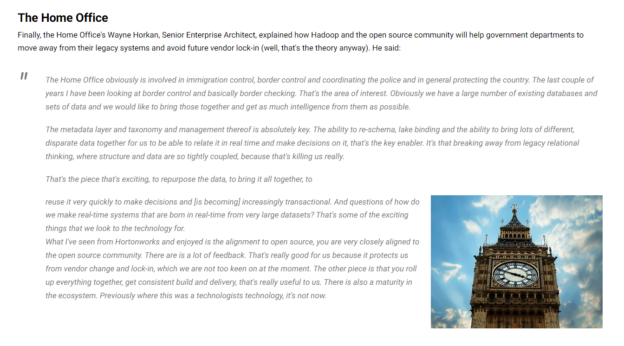In September 2015, I had the opportunity to represent the Home Office and Border Force in a panel discussion at an event covered by Diginomica, where we delved into the transformative potential of Big Data and Machine Learning technologies. Alongside industry leaders from Jaguar Land Rover and Zurich Insurance, I discussed how the Home Office is actively leveraging Hadoop and other open-source tools to modernise its data management and decision-making processes, particularly within border security operations.
Breaking Free from Legacy Systems
A key focus of my presentation was the need for the Home Office to move away from the constraints of legacy systems, which have historically hampered our ability to make real-time, informed decisions. These older systems, often characterised by tightly coupled data and structure, limit the flexibility and responsiveness that modern border security operations require. By embracing Big Data technologies like Hadoop, we’re not only improving the efficiency of our data management but also significantly enhancing our ability to respond to dynamic threats.
One of the primary advantages of using Hadoop and other open-source technologies is the ability to integrate and repurpose disparate data sets quickly. The Home Office handles vast amounts of data across multiple systems, from immigration control to law enforcement databases. The challenge has always been how to bring these data sets together in a way that allows us to extract meaningful intelligence and act on it in real-time.
Metadata Management and Real-Time Decision-Making
During the panel, I emphasised the importance of metadata management and taxonomy as key enablers in our Big Data strategy. The ability to re-schema and lake-bind, essentially reorganising and repurposing data dynamically, enables us to make real-time decisions based on the most current and comprehensive data available. This is particularly crucial in border control operations, where the ability to act swiftly on the latest intelligence can have significant implications for national security.
By adopting these modern data management techniques, we’re moving towards a future where our systems are not only more efficient but also capable of handling the increasing demands of a real-time, transactional world. This shift allows the Home Office to improve its overall operational effectiveness, ensuring that our border security measures are both robust and adaptable.
Avoiding Vendor Lock-In and Ensuring Flexibility
Another critical point I discussed was the Home Office’s commitment to avoiding vendor lock-in. Historically, reliance on proprietary systems has led to a lack of flexibility and higher costs. By aligning with the open-source community, the Home Office is not only reducing its dependence on any single vendor but also ensuring that our systems can evolve in line with technological advancements.
The open-source approach also allows us to benefit from the collective innovation of the global tech community. This is particularly important in the rapidly evolving field of Big Data, where the ability to adapt and incorporate the latest developments can provide a significant strategic advantage.
The Future of Big Data in Government
Looking ahead, the integration of Big Data and Machine Learning technologies within the Home Office represents a significant step forward in modernising our approach to border security. These technologies offer the potential to transform how we gather, analyse, and act on information, ultimately making the UK safer and more secure.
As we continue to refine and expand our use of these tools, the lessons learned from this early adoption phase will be critical in guiding future developments. The Home Office is committed to staying at the forefront of this technological wave, ensuring that our border control systems remain effective, efficient, and adaptable in the face of new challenges.
For a more detailed look at the panel discussion and the insights shared by other industry leaders, you can read the full diginomica article.
